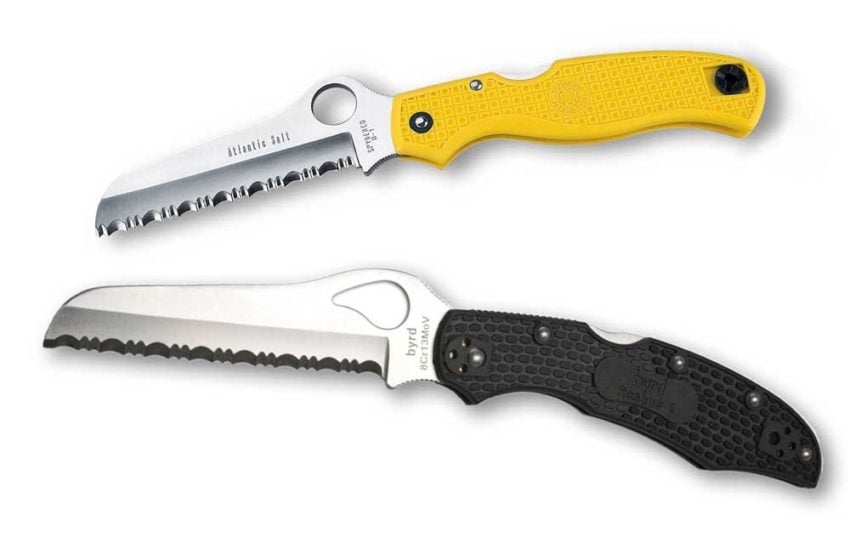I wanted to subtitle this review: A Tale of Two Knives, to reflect the vast differences between two otherwise similar-looking blades. Alas, literature and knives don’t always work so well together. Still, I love knives. One of my very first jobs was a whitewater raft guide, and a necessary piece of gear was a good knife. The knife was to be used for cutting cordage and other materials (where a serrated blade comes in handy), and needed to be very sharp, easy to hold, and rust resistance was a major plus. In addition to what it was supposed to be used for, many a knife was used to open bottles, spread food products (and foodborne pathogens) and to hammer, pry, and sometimes even screw things together (Ouch!). Knives on the water have a hard life. I’ll get to the Byrd Rescue 2 knife (or Byrd Cara Cara Rescue 2 knife) in just a second.
My boating tends to be divided into two types: Whitewater and non-whitewater. For whitewater, I used a Benchmade 110SH20 knife, a fixed blade model. It has a fantastic sheath, great blade, and makes me very happy. Of course, it has been discontinued, and so I’m always on the lookout for one to pick up as a spare. For non-whitewater, I keep a folder on me, and for the last 6 years, it has been a Yellow Spyderco Atlantic Salt.
I’ve had a fairly long relationship with Spyderco, and have owned quite a few of their knives for EDC, kitchen work, and riding on my PFD (personal floatation device). Spyderco knives are available in a plain edge and Spyderedge which is Spyderco’s proprietary serration pattern.
The Spyderco Atlantic Salt Knife Reference
The Spyderedge is fairly terrifying and makes short work of almost all cordage and soft goods it meets. My Atlantic Salt has a sheepsfoot style blade which means no sharp point to poke holes where they’re not needed. It’s also very handy when having to make a cut close to someone else’s skin.
Spyderco’s folders also all feature a thumbhole to allow for an easy one-handed open, and the clip can be switched to either side depending on your dominant hand. In the dark, underwater, and in a really bad place, it is possible to confidently open the knife and be able to use it. The lock is on the spine of the knife and it’s fairly easy to operate single-handedly as well. The opening of the blade is smooth as silk, and you can fully open it in a single swift motion.
The Spyderco Atlantic Salt knife has plastic scales imprinted in what it calls a “volcano pattern” and offers a firm grip in almost all situations. (I have yet to find a condition where I could not get a firm grip, but allow the possibility that it could exist.)
Spyderco’s original steel tends to rust in my use of it on the water, which is why I ended up switching from my original Rescue to the Salt. Its H1 stainless steel has been rust-free in both marine and freshwater conditions. The only bummer is the cost. Street for an H1 Salt is around $129, and that is a lot of money for a folder.
Is it worth it? Yes. Is it cheap? Nope.
Byrd Rescue 2 Knife to the, um…Rescue?
This is when our review title will begin to make sense. Over the weekend I stumbled upon a Byrd Rescue 2 knife (also called the Byrd Cara Cara Rescue 2 knife). It had a very familiar edge, shape, and feel—but at a price of just $39.99 (even less in some places). It uses a chrome vanadium stainless steel blend for the blade, has plastic scales, and a metal clip. The plastic edges of the scales are sharper, and it does not feel as nice in the hand.
The teardrop cut out in the blade is effective, just not as refined as the Spyderco Atlantic Salt knife. It seems to be almost a Honda/Acura or Toyota/Lexus story—a relationship that’s not at all hidden by Spyderco. You can see and feel the knife’s common heritage, but the Salt is clearly more refined. The Spyderco’s are also made in Seki City in Japan, while the Byrd Rescue 2 knife is stamped as being made in China.
So is the Spyderco Altantic Salt $90 dollars more refined than the Byrd Rescue 2 knife? Possibly. But probably not if you aren’t worried about corrosion resistance. I would have no problem carrying the Byrd on the river or as an EDC provided I took care of it and didn’t mind having to sharpen it more often. This new Byrd Rescue 2 will be replacing the fixed blade knife that fell off my son’s PFD and sank.
Byrd has a handful of other knives patterned after its far more expensive brethren, that will be similarly effective in the field. The only decision you have to make is whether you want to pay for the extra quality of a better-crafted product—or make due with the lesser developed Byrd models.







